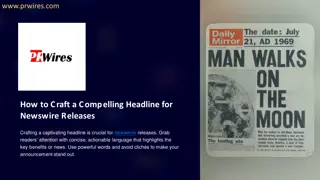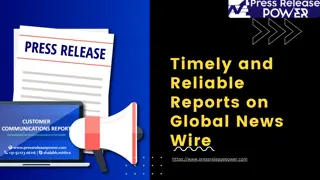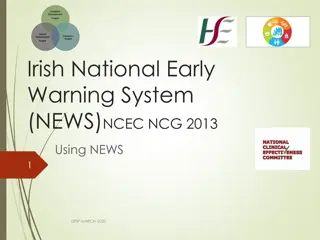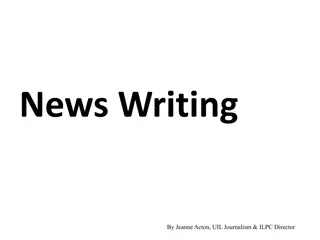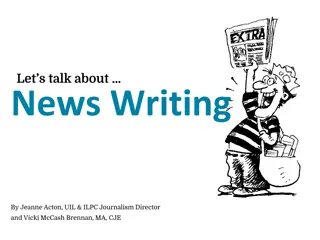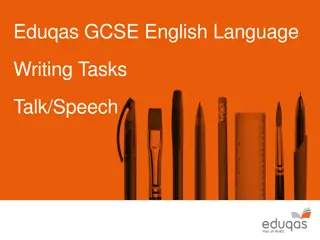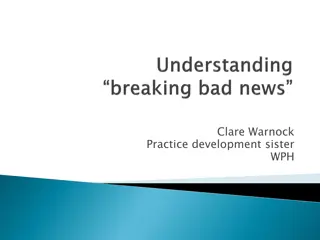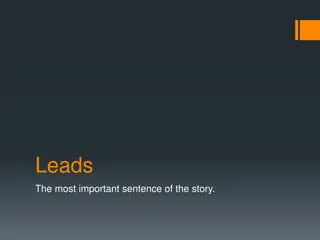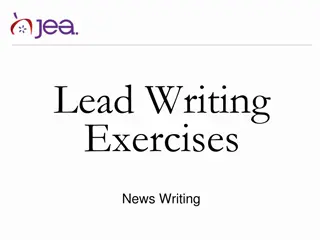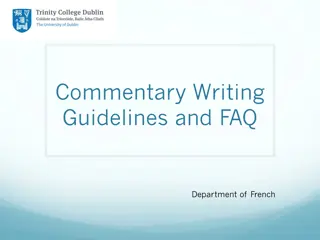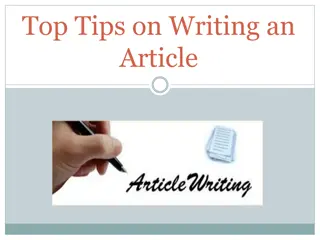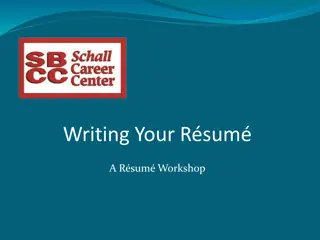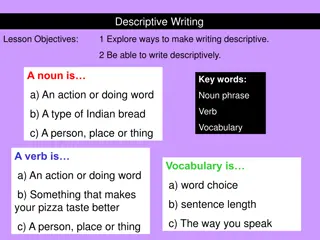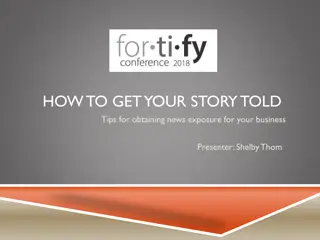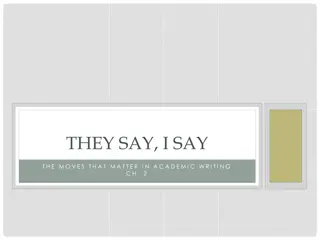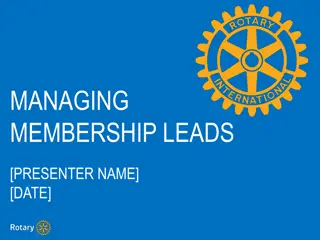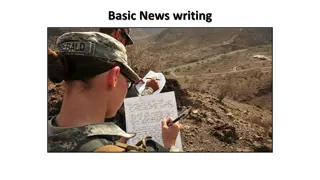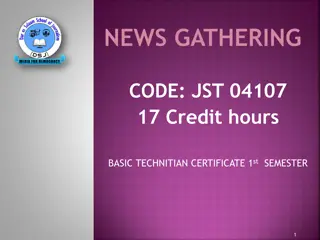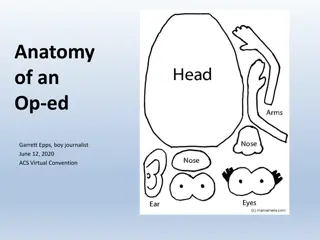Mastering News Writing: The Art of Compelling Leads
Understanding the essence of news writing through this piece which highlights the significance of a strong lead, the power of student-written leads, and the various types of news leads like the NEWS or summary lead, what lead, why lead, and how lead. Dive into the world of journalism alongside experts Jeanne Acton and Vicki McCash Brennan.
Uploaded on Jul 29, 2024 | 0 Views
Download Presentation

Please find below an Image/Link to download the presentation.
The content on the website is provided AS IS for your information and personal use only. It may not be sold, licensed, or shared on other websites without obtaining consent from the author. Download presentation by click this link. If you encounter any issues during the download, it is possible that the publisher has removed the file from their server.
E N D
Presentation Transcript
Basic Lead Writing News Writing
Lets talk about News Writing By Jeanne Acton, UIL & ILPC Journalism Director and Vicki McCash Brennan, MA, CJE
News gives readers information that will impact them or interests them in some way. News is anything that's interesting, that relates to what's happening in the world, what's happening in areas of the culture that would be of interest to your audience. Kurt Loder, music journalist, former editor of Rolling Stone
What is a lead? It s the first sentence of the story, the beginning. It tells the most important information and the newest information. It grabs your readers attention. But there s more
What must your lead do? Start a flow of energy for your story Tell something interesting about the subject of the story Show the significance of the story Set pace and tone Establish your voice That s a lot!
Some great student-written leads She peeked around the door leading to the 500 Hall. Hey, she whispered, is Mrs. Solomon looking? Five minutes later, the girl with darting eyes would be silently speed walking towards the black gate, trying to leave school during C Lunch. [Hillsborough High School] Freshman Noah Barboza likes to spend his time lifting at the gym, not lifting textbooks around school. Barboza is constantly struggling with the pain of carrying his books around campus on his way to his eight class periods. [Cypress Bay High School] At first glance, senior basketball player Myron Dewar might pass through halls unnoticed. His only striking feature is his strange, indifferent gaze that seems to hide his past, his thoughts, his inner turmoil. [Coral Springs High School]
The NEWS or summary lead Tells the 5W s and H in 25 words or fewer. Starts with the MOST IMPORTANT or INTERESTING information first. Can start with any of the 5W s or H, but some choices are better than others What does your reader need to know most?
Types of news leads Use these often: What lead Starts with what happened or what the story is about. Why lead Begins with the cause of the story, why it happened. How lead Begins with how the event happened.
Types of news leads Use this sometimes: Who lead Starts with a person or group. Use this if who the story is about is well known or interesting. Avoid these: When lead Begins with time. Almost never the most important factor. Where lead Begins with a place. Rarely is this the most important factor.
The who lead When the person you re writing about is the most important reason you re writing the story, then start with who. President Barack Obama will greet students in the courtyard Thursday after his speech at the Expo Center. Maybe Students will no longer be allowed to leave campus for lunch due to excessive after-lunch tardies, Principal Joe Blow said Tuesday. Definitely NO! Principal Joe Blow announced Tuesday that students will no longer be allowed to leave campus for lunch due to excessive tardies.
The who lead Does not need a name to work. Sometimes identifying the who by an occupation or accomplishment will do it as long as the person is interesting enough to hook your reader. Yes Endurance swimmer Diana Nyad, 64, became the first person to complete a 110-mile swim from Cuba to Florida without a shark cage. It took her 53 hours.
The when lead Do not start with the time element. It s almost never the most important factor. Definitely no! On Tuesday Principal Joe Blow announced that students will no longer be able to leave campus for lunch. Maybe, for an anniversary story ... Fifty years ago, on Nov. 22, 1963, President John F. Kennedy was shot and killed in Dallas. It was a defining moment for the country, one that people older than 55 remember the way most American adults remember Sept. 11.
The where lead Don t start with a place, either. It s almost never the most important or interesting factor. Definitely no! At the school board meeting on Tuesday, Principal Joe Blow announced that he has ended the off-campus lunch policy. Maybe but maybe not In the principal s office, the senior class dumped 30 pounds of sand to protest the cancellation of the senior trip to Cancun. And again: Why is this type of lead rarely almost never used?
On the topic of where News writers handle the where with a DATELINE, a city name in all caps before the lead to say where the story originated. CATANIA, Italy More than 800 people were believed to have drowned in the weekend sinking of a boat packed with migrants trying to reach Europe, the United Nations refugee agency said Tuesday. Datelines are not used on local news stories where the place is understood. Similarly, there s no need for datelines student newspapers, websites and yearbooks to name your school. Readers know where you are.
The why lead This kind of lead starts a story by explaining WHY something unusual happened. WHY answers: What caused this to happen? Use this often! Example: To carry on a tradition that started in the 1970s, four seniors streaked across the football stadium during the homecoming pep rally wearing only paper leis and tennis shoes.
The how lead Similar to the why lead, this kind of lead explains how something happened. Use this only when the explanation is short, clear and interesting. How sometimes requires more explanation than you can fit in a lead, but when you can, use the how. Example: Through a grassroots effort by young voters, Gilbert Castillo, 18, won the election Tuesday to become the youngest mayor in the city s history. Is there a better way to write this lead?
The what lead Use this most often. This is the most straight- forward. If you can t write this lead, you don t know enough to be writing the story. WHAT tells WHAT HAPPENED. There might be more than one what in the story, so figure out which what is most interesting to your readers. Examples: The Harry Potter series and Lord of the Rings series won t be found on school library shelves this fall. School libraries will remove the Lord of the Rings and Harry Potter series from shelves this fall.
A great what lead More than 300 women were shot, stabbed, strangled, beaten, bludgeoned, or burned to death over the past decade by men in South Carolina, dying at a rate of one every 12 days while the state does little to stem the carnage from domestic abuse. Post and Courier, Charleston, South Carolina. The story Till Death Do Us Part won the 2015 Pulitzer Prize for Public Service and was written by Doug Pardue, Glenn Smith, Jennifer Berry Hawes, and Natalie Caula Hauff
Why learn to write the summary lead? Yes, of course, there are lots of other ways to start a story. Basic LEADS Basic news or Summary lead Anecdotal or narrative (storytelling) Descriptive (scene-setting) Less-used feature LEADS Metaphor or simile Word play: puns, alliteration Action Contrast, twist of fate Shocking statement Freak lead What information needs to be in your story no matter how you start?
Its your turn Use the information on the next slide to practice your lead writing skills. Write six different leads using this information, one beginning with each of the 5W s and H. After you have written all six leads, circle the one you think is strongest.
Write the lead (well, six leads!) A baby macaw parrot was stolen from the Baby Exotic Birds store in Lakewood. Jill O Connor, 35, faces felony charges for stealing the bird, worth $2,000. O Connor was employed at Baby Exotic Birds. She traded the bird for a 2000 Mercury Cougar. She bragged to the car owners that she d smuggled the bird out of the store by nesting it in her brassiere. The car owners were friends with the owners of the bird store. They reported the theft. O Connor was booked into the county jail.
While were on this topic Three leads to avoid 1. Question Leads Usually, question leads are just weak and uninteresting. Get to the point with a summary lead instead. Have you ever wondered (No. Next ) 2. Quote Leads Quotes need context. The reader needs to know who s speaking. Seldom is a quote so compelling and well-said that it can set the tone and focus for the whole story. Just don t write these leads.
While were on this topic Three leads to avoid 3. Topic Leads It is not enough to just state the topic of your story. These are some of the worst leads ever: On April 25 at the Shockley Community Center, prom was held. The school board met Tuesday to discuss problems with school lunch. The Bulldogs played the Hurricanes Friday in a crucial conference game. With Thanksgiving coming, people are thinking about food. Just don t write these leads.
Every story needs a summary Regardless of what you are writing about, the 5W s and H belong in the story. If you get in the habit of writing a summary lead for EVERY STORY, you will always have the basics covered even if you end up with a different kind of lead. A bonus: Your feature leads will have a better focus, because they have to lead into your summary!
How to write effective news leads Now you know you can start your leads in different ways, but how do you find the BEST lead for your story? Use this four-step process.
How to write an effective news lead* 1. Collect all your facts. REPORTING is key. Who: What person or group is this story about? There might be more than one. List them all. What: What happened? What is the issue, problem or conflict? Explain it. When: Day, date, time Where: Be as specific as possible Why: Why did this happen? Provide context. How: How did it happen? Provide details. *Adapted from Inside Reporting by Tim Harrower
How to write an effective news lead* 2. Sum it up, boil it down. If you had just 10 seconds to tell the story, what would you say? How would you tell it to your best friend? How would you tweet it? If telling your mom, would you tell it differently? Tell the story out loud to yourself or a friend. *Adapted from Inside Reporting by Tim Harrower
How to write an effective news lead* 3. Prioritize the 5Ws. Which of the 5W s or H is most compelling, most interesting? Write a draft of your lead focusing on that fact, usually the what, why or how. Use the who only if the person is someone interesting or prominent. Avoid starting with when or where. *Adapted from Inside Reporting by Tim Harrower
How to write an effective news lead* 4. Rethink, rewrite, revise. Here s where you stop thinking that your first draft is good enough. It is not. Ask yourself: Is this clearly written so everyone can understand it? Is it in the active voice? (Who did what to whom?) Are there extra words you don t need? Will this grab the readers and make them want to keep reading? *Adapted from Inside Reporting by Tim Harrower
Create a concept map Using your notes from this presentation and any other resources available in the classroom, create a concept map showing how to write a basic news lead, also called a summary lead or a direct lead. Your map should: define lead (the center of the map) name each of the 5W s and H, and when they should be used to start a story (five prongs) describe the four-step process of how to write a summary lead (a sub category with four prongs)



